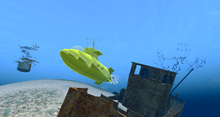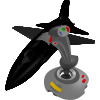
A submarine is a watercraft capable of independent operation underwater. It differs from a submersible, which has more limited underwater capability. The term is also sometimes used historically or colloquially to refer to remotely operated vehicles and robots, as well as medium-sized or smaller vessels, such as the midget submarine and the wet sub. Submarines are referred to as boats rather than ships irrespective of their size.

USS Dolphin (AGSS-555) was a United States Navy diesel-electric deep-diving research and development submarine. She was commissioned in 1968 and decommissioned in 2007. Her 38-year career was the longest in history for a US Navy submarine to that point. She was the Navy's last operational conventionally powered submarine.

A remotely operated vehicle (ROV) is a free-swimming submersible craft used to perform tasks such as valve operations, hydraulic functions and other general tasks within the subsea oil and gas industry. ROVs can also carry tooling packages for undertaking specific tasks such as pull-in and connection of flexible flowlines and umbilicals, and component replacement.

USS Scorpion (SSN-589) was a Skipjack-class nuclear-powered submarine that served in the United States Navy, and the sixth vessel, and second submarine, of the U.S. Navy to carry that name.

A submersible is an underwater vehicle which needs to be transported and supported by a larger watercraft or platform. This distinguishes submersibles from submarines, which are self-supporting and capable of prolonged independent operation at sea.

A midget submarine is any submarine under 150 tons, typically operated by a crew of one or two but sometimes up to six or nine, with little or no on-board living accommodation. They normally work with mother ships, from which they are launched and recovered and which provide living accommodation for the crew and support staff.

USS Skipjack (SSN-585), the lead ship of her class of nuclear-powered attack submarine, was the third ship of the United States Navy to be named after the skipjack tuna.

A survey vessel is any type of ship or boat that is used for underwater surveys, usually to collect data for mapping or planning underwater construction or mineral extraction. It is a type of research vessel, and may be designed for the purpose, modified for the purpose or temporarily put into the service as a vessel of opportunity, and may be crewed, remotely operated, or autonomous. The size and equipment vary to suit the task and availability.
SSN-21 Seawolf is a submarine simulator game designed by John W. Ratcliff and published for MS-DOS systems by Electronic Arts on April 3, 1994. A 3DO Interactive Multiplayer version was planned but never released.

An autonomous underwater vehicle (AUV) is a robot that travels underwater without requiring continuous input from an operator. AUVs constitute part of a larger group of undersea systems known as unmanned underwater vehicles, a classification that includes non-autonomous remotely operated underwater vehicles (ROVs) – controlled and powered from the surface by an operator/pilot via an umbilical or using remote control. In military applications an AUV is more often referred to as an unmanned undersea vehicle (UUV). Underwater gliders are a subclass of AUVs.

Marine engineering is the engineering of boats, ships, submarines, and any other marine vessel. Here it is also taken to include the engineering of other ocean systems and structures – referred to in certain academic and professional circles as “ocean engineering.”

Unmanned underwater vehicles (UUV), sometimes known as underwater drones, are submersible vehicles that can operate underwater without a human occupant. These vehicles may be divided into two categories: remotely operated underwater vehicles (ROUVs) and autonomous underwater vehicles (AUVs). ROUVs are remotely controlled by a human operator. AUVs are automated and operate independently of direct human input.
AquaNox is a series of submarine-based first-person shooter/simulation video games set in the distant future. The collection includes AquaNox, AquaNox 2: Revelation and AquaNox: The Angel's Tears. The predecessor and the starter of the series is the MS-DOS title Archimedean Dynasty.

A wet sub is a type of underwater vehicle, either a submarine or a submersible, that does not provide a dry environment for its occupants. It is also described as an underwater vehicle where occupants are exposed to ambient environment during operations. The watercraft is classified as medium-sized or small vessel. This type of submarine differs from other underwater personal transport devices by the fact that it has a hull around it and it is not a "bare bones" design.

The SACLANT ASW Research Centre was the predecessor to the NATO Undersea Research Centre. It was known as The SACLANT ASW Research Centre from 1959 through 1986, and the SACLANT Undersea Research Centre from 1987 through 2003. The centre was commonly referred to as SACLANTCEN.

The ASW Continuous Trail Unmanned Vessel (ACTUV) is a DARPA funded project launched in early 2010 to develop an anti-submarine drone. ASW is an acronym for Anti-Submarine Warfare. In January 2018 after successful sea trials it was announced that the "Sea Hunter" prototype has transitioned from DARPA to the Office of Naval Research for further development.
Peral was the first successful full electric battery-powered submarine, built by the Spanish engineer and sailor Isaac Peral for the Spanish Navy, in Arsenal de la Carraca. The first fully capable military submarine, she was launched 8 September 1888. She had one torpedo tube and an air regeneration system. Her hull shape, propeller, periscope, torpedo launcher and cruciform external controls anticipated later designs. Her underwater speed was 3 knots. With fully charged batteries, she was the fastest submarine yet built, with underwater performance levels that matched those of First World War U-boats for a very short period, before her batteries began to drain. For example, the SM U-9, a pre-war German U-boat built in 1908, had an underwater speed of 8.1 knots, and an underwater range of 150 km (81 nmi) at 5.8 knots, before having to resurface to recharge her batteries. Although advanced in many ways, Peral lacked a means of charging batteries while underway, such as an internal combustion engine, thus had a very limited endurance and range. In June 1890, Peral's submarine launched a torpedo while submerged. It was also the first submarine to incorporate a fully reliable underwater navigation system. However, conservatives in the Spanish naval hierarchy terminated the project despite two years of successful tests. Her operational abilities have led some to call her the first U-boat.

The Fleet-class unmanned surface vessel, also called the Common Unmanned Surface Vessel (CUSV) and later the Mine Countermeasures Unmanned Surface Vehicle, is an unmanned surface vessel designed for the United States Navy to be deployed from Freedom and Independence-class littoral combat ships and intended to conduct mine and anti-submarine warfare missions. As of 2012 four units of the class have been built; the first was delivered to the U.S. Navy in 2008.

SPINDLE is a 2-stage autonomous vehicle system consisting of a robotic ice-penetrating carrier vehicle (cryobot) and an autonomous submersible HAUV . The cryobot is designed to descend through an ice body into a sub-surface ocean and deploy the HAUV submersible to conduct long range reconnaissance, life search, and sample collection. The HAUV submersible will return to, and auto-dock with, the cryobot at the conclusion of the mission for subsequent data uplink and sample return to the surface.
Barotrauma is a survival-horror role-playing submarine simulator developed by Finnish studio Undertow Games and published by Daedalic Entertainment. Following an early access beta phase that began in 2019, the game was released for Windows, macOS, and Linux in March 2023.

















